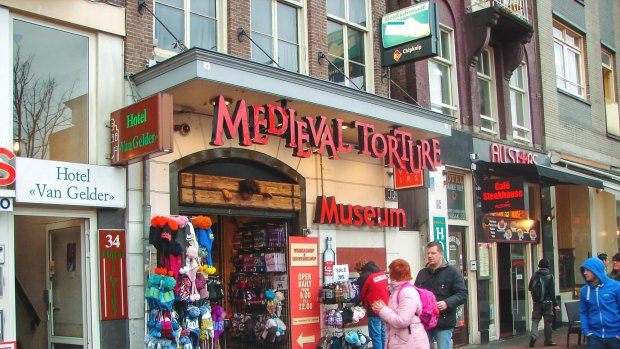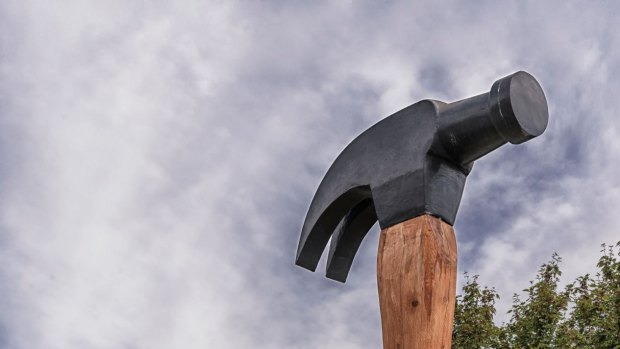By Lee Tulloch

The Museum of Medieval Torture in Amsterdam.Credit: Alamy
I admit it, I'm addicted to weird museums. Whenever my travelling companions are heading off to visit the Louvre, or New York's Metropolitan or London's Tate, I have other plans. A museum where 300-year-old dead bodies, injected with wax to preserve them, are displayed, perhaps? You bet!
I'm not sure which weird museum started it all but my first memories of an idiosyncratic collection was the suburban house of The Fairy Lady, as we called her, in Kew, Melbourne. For some reason unknown to me, this sweet elderly lady was obsessed with fairies and filled her garden with statues of them. Since then, I've been always intrigued as much by the reasons behind the collection as the collection itself.
Take Leila Cohoon of Leila's Hair Museum in Independence Missouri, for instance. I have a friend in the US who often talks about this museum, which features Leila's collection of more than 2000 pieces of hair jewellery, from framed wreaths to lockets containing snippets of hair, popular in the Victorian era. She collects celebrity locks too - those of Queen Victoria and Michael Jackson the most prized examples. Leila's most expensive piece? The first wreath she bought in 1956, "because look at what it started", says her long-suffering husband Don.

The Hammer Museum in Haines, Alaska. Credit: Alamy
There's another hair museum in the world, believe it or not. This one's in Avanos, Turkey, created by potter Chez Galip more than 30 years ago when a woman friend left him a lock of her hair to remember her by. Now he has locks from the heads of more than 16,000 women, attached to labels and hung in a cave. He must be a popular man.
You name it, there's someone obsessively collecting and exhibiting it. I once visited by ship the quite inaccessible town of Haines, Alaska. One of its main attractions is the Hammer Museum. Why would this pretty village showcase something so prosaic? It's the brainchild of Dave Pohl, who moved from Ohio in the 1970s, became a blacksmith and started collecting hand tools.
Other curious museums include the Sulabh International Museum of Toilets in New Delhi, which showcases 4500 years of toilet history, the Icelandic Phallological Museum in Reykjavik, otherwise known as the "penis" museum, which has more tha 200 penises and penile parts from animals on display, and National Mustard Museum in Middleton, Wisconsin, which has in its archives 5624 different kinds of mustard.
Many weird museums celebrate food, such as the Deutsches Currywurst Museum in Berlin, the Idaho Potato Museum, the Maine Lobster Museum and the fabulously named Momofuku Ando Instant Ramen Museum in Osaka, dedicated to the work of the creator of instant cup noodles. There's a Garbage Museum in Connecticut to take care of all the wrappers.
If you have a broken heart, there's the Museum of Broken Relationships in Zagreb, Croatia, a collection of donated items relating to failed relationships, such as an axe a woman used to chop up her lover's furniture. If you're doing better in the romance stakes, there's a Condom Museum in Nonthaburi, Thailand.
I prefer the really creepy museums, however, such as the Museum of Medieval Torture Instruments in Amsterdam and the Meguro Parasitological Museum in Tokyo, dedicated to parasites, ticks and tapeworms. There's the Cockroach Hall of Fame in Phoenix Arizona, although I could probably start up one of them in my own house.
Which leads me to my absolute favourite museum in the world, the Fragonard Museum in Paris. It sounds lovely, doesn't it, bringing forth images of 18th century ladies in frothy dresses on swings. But the museum is not dedicated to the painter Jean-Honore Fragonard, but his twisted cousin, Honore, who was the Professor of Anatomy at the National Veterinary School for six years until he was expelled as a madman in 1771.
Fragonard was convinced he could preserve bodies by injecting them with wax. He found many of his bodies floating in the Seine and illegally experimented on them. He would arrange them in dramatic displays, on horseback or standing ferociously with a club. Three foetuses join hands and dance. But it didn't go so well - the technique dried the skin and today it peels off the figures like bark.
Known as his ecorches, the flayed figures are still on display in glass cases at the veterinary school at Maisons-Alfort, a suburb of Paris. It's mad, spooky and difficult to get to. Almost no one knows about it. All reasons why I love it.
Sign up for the Traveller Deals newsletter
Get exclusive travel deals delivered straight to your inbox. Sign up now.